Books on historical topics bring to life events and individuals, some of them familiar and some new, for readers. The stories reviewed in this week’s column make engaging reading for pleasure and for learning about different places and time periods.
Ages 4–8
Born to Ride: A Story About Bicycle Face. Larissa Theule. Ill. Kelsey Garrity-Riley. 2019. Abrams.
 The year is 1896, and Louisa Belinda Bellflower is told she can’t ride a bicycle because girls are not strong enough to balance and, in trying to ride, their eyes will bulge and jaws clench, giving them “bicycle face,” which can be permanent. Determined to ride, she trades her restrictive dress for her brother’s trousers and, though she falls again and again, she learns to ride. Her bicycle face is a “gigantic, joyous smile.” Whimsical naïve paintings depict Louisa Belinda’s activities and scenes of Rochester, New York, bustling with bicycle riders. The final double-page spread pictures many women and girls (including Louisa Belinda and her mother dressed in pants) cycling to join a women’s suffrage rally. Back matter has more information about restrictions on women in the 1890s and describes women’s efforts, in the face of resistance, to become wheelwomen.
The year is 1896, and Louisa Belinda Bellflower is told she can’t ride a bicycle because girls are not strong enough to balance and, in trying to ride, their eyes will bulge and jaws clench, giving them “bicycle face,” which can be permanent. Determined to ride, she trades her restrictive dress for her brother’s trousers and, though she falls again and again, she learns to ride. Her bicycle face is a “gigantic, joyous smile.” Whimsical naïve paintings depict Louisa Belinda’s activities and scenes of Rochester, New York, bustling with bicycle riders. The final double-page spread pictures many women and girls (including Louisa Belinda and her mother dressed in pants) cycling to join a women’s suffrage rally. Back matter has more information about restrictions on women in the 1890s and describes women’s efforts, in the face of resistance, to become wheelwomen.
—SW
Follow Me to Nicodemus Town: Based on the History of the African American Pioneer Settlement. A. LaFaye. Ill. Nicole Tadgell. 2019. Albert Whitman.
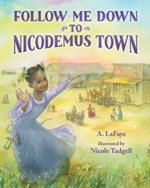 Dede Patton, who earns pennies shining shoes at the train station, returns the wallet a man dropped while racing to catch his train and receives a reward of 10 dollars. Her parents, who work from “sun-climb to sun-slide” as sharecroppers, now have enough money to take advantage of the U.S. government’s offer of free land to homestead on the Kansas prairie near a soon-to-built town, Nicodemus. Warm, richly detailed watercolor illustrations show the experiences of the Patton family as they survive years of hardship during which they build a sod house, work the land and grow crops, and finally see their dream of owning their own farm come true. Historical context is provided in a note on the Exodusters, the African Americans who participated in the land rush to the frontier in the 1870s, and the development of Nicodemus.
Dede Patton, who earns pennies shining shoes at the train station, returns the wallet a man dropped while racing to catch his train and receives a reward of 10 dollars. Her parents, who work from “sun-climb to sun-slide” as sharecroppers, now have enough money to take advantage of the U.S. government’s offer of free land to homestead on the Kansas prairie near a soon-to-built town, Nicodemus. Warm, richly detailed watercolor illustrations show the experiences of the Patton family as they survive years of hardship during which they build a sod house, work the land and grow crops, and finally see their dream of owning their own farm come true. Historical context is provided in a note on the Exodusters, the African Americans who participated in the land rush to the frontier in the 1870s, and the development of Nicodemus.
—CA
How Emily Saved the Bridge: The Story of Emily Warren Roebling and the Building of the Brooklyn Bridge. Frieda Wishinsky. Ill. Natalie Nelson. 2019. Groundwood/House of Anansi.
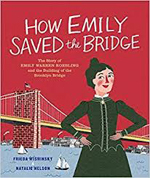 Growing up during a time when “many girls were told they weren’t smart, especially in math or science,” Emily Warren (1843–1903) was eager to learn all she could and received a good education before marrying Washington Roebling, a soldier and engineer. In 1869, Emily encouraged her husband to take on the supervision of the construction of the suspension bridge across the East River following the accidental onsite death of his father, the chief engineer. When illness prevented Washington from continuing the work, Emily took over the challenging project, and the Brooklyn Bridge was completed in 1883. Colorful artwork created with digital collage and found photographs with imagined dialogue balloons complement this story of how Emily saved the bridge. Back matter includes interesting facts about the Brooklyn Bridge, suggestions for further reading, source notes, and an author’s note.
Growing up during a time when “many girls were told they weren’t smart, especially in math or science,” Emily Warren (1843–1903) was eager to learn all she could and received a good education before marrying Washington Roebling, a soldier and engineer. In 1869, Emily encouraged her husband to take on the supervision of the construction of the suspension bridge across the East River following the accidental onsite death of his father, the chief engineer. When illness prevented Washington from continuing the work, Emily took over the challenging project, and the Brooklyn Bridge was completed in 1883. Colorful artwork created with digital collage and found photographs with imagined dialogue balloons complement this story of how Emily saved the bridge. Back matter includes interesting facts about the Brooklyn Bridge, suggestions for further reading, source notes, and an author’s note.
—CA
Ages 9–11
Allies. Alan Gratz. 2019. Scholastic.
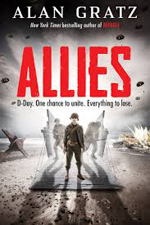 Alan Gratz tells the dramatic story of D-Day from the points of view of a diverse group of individuals representing participants in the Allied invasion of Normandy on June 6, 1944: paratroopers who landed first, soldiers who stormed the beaches, medics who tended the wounded, and members of the French Resistance who spied on the German army and sabotaged roads, railways, and telephone lines. Extensive author’s notes offer details on the complicated, international mission, code-named Operation Overlord; the beach invasion, Operation Neptune; and other operations for which Gratz created names to separate the stories of the fictional characters; and changes he made to limit the occurrence of events to a single day—from just before dawn on the English Channel to close to midnight on the road to Bayeux on D-Day.
Alan Gratz tells the dramatic story of D-Day from the points of view of a diverse group of individuals representing participants in the Allied invasion of Normandy on June 6, 1944: paratroopers who landed first, soldiers who stormed the beaches, medics who tended the wounded, and members of the French Resistance who spied on the German army and sabotaged roads, railways, and telephone lines. Extensive author’s notes offer details on the complicated, international mission, code-named Operation Overlord; the beach invasion, Operation Neptune; and other operations for which Gratz created names to separate the stories of the fictional characters; and changes he made to limit the occurrence of events to a single day—from just before dawn on the English Channel to close to midnight on the road to Bayeux on D-Day.
—CA
Captain Rosalie. Timothée de Foblelle. Trans. Sam Gordon. Ill. Isabelle Arsenault. 2019. Candlewick.
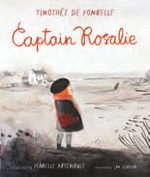 “I have a secret,” says 5-year-old Rosalie, whose father is fighting on the front during World War I. While her mother works in a factory, the teacher lets Rosalie spend the day at the back of the older children’s classroom. They think she’s just drawing in her notebook and daydreaming, but she’s a soldier with a special mission. Some evenings her mother reads aloud the cheery letters from her father. The nature of Rosalie’s secret mission—to learn to read— is revealed after a gendarme delivers a letter that her mother does not read to her. She steals home during the day to find out what her father really says in his letters (“At night I cry in the mud or Oh, my darling, you will never see me again.”) and the letter from the Ministry of War (“Killed in action fighting for his country”). Expressive mixed-media artwork beautifully complements this quiet, powerful wartime story.
“I have a secret,” says 5-year-old Rosalie, whose father is fighting on the front during World War I. While her mother works in a factory, the teacher lets Rosalie spend the day at the back of the older children’s classroom. They think she’s just drawing in her notebook and daydreaming, but she’s a soldier with a special mission. Some evenings her mother reads aloud the cheery letters from her father. The nature of Rosalie’s secret mission—to learn to read— is revealed after a gendarme delivers a letter that her mother does not read to her. She steals home during the day to find out what her father really says in his letters (“At night I cry in the mud or Oh, my darling, you will never see me again.”) and the letter from the Ministry of War (“Killed in action fighting for his country”). Expressive mixed-media artwork beautifully complements this quiet, powerful wartime story.
—CA
Ages 12–14
1919: The Year That Changed America. Martin W. Sandler. 2019. Bloomsbury.
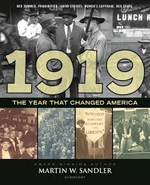 1919, the year after the armistice ending World War I and the second year of the deadly influenza pandemic, was also the year that saw other events that changed America including the passage of the 19th amendment that ensured women’s right to vote, the introduction of prohibition, the rise of organized labor, and the chaos of race riots resulting from growing resistance to racial discrimination. The book opens with a tragic event, the Great Molasses Flood that destroyed a large section of the city of Boston when a giant storage tank of molasses exploded on January 15, a tragic event that raised awareness of the need for government oversight of big business. Illustrated with archival photographs, each chapter details a different major movement and ends with a “One Hundred Years Later” section covering related events and a timeline. Back matter includes books and resources for further reading, a list of Sandler’s research sources, and an index.
1919, the year after the armistice ending World War I and the second year of the deadly influenza pandemic, was also the year that saw other events that changed America including the passage of the 19th amendment that ensured women’s right to vote, the introduction of prohibition, the rise of organized labor, and the chaos of race riots resulting from growing resistance to racial discrimination. The book opens with a tragic event, the Great Molasses Flood that destroyed a large section of the city of Boston when a giant storage tank of molasses exploded on January 15, a tragic event that raised awareness of the need for government oversight of big business. Illustrated with archival photographs, each chapter details a different major movement and ends with a “One Hundred Years Later” section covering related events and a timeline. Back matter includes books and resources for further reading, a list of Sandler’s research sources, and an index.
—SW
O Captain, My Captain: Walt Whitman, Abraham Lincoln, and the Civil War. Robert Burleigh. Ill. Sterling Hundley. 2019. Abrams.
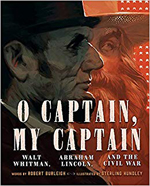 With Robert Burleigh’s lyrical text and Sterling Hundley’s beautifully composed mixed-media illustrations, O Captain, My Captain weaves together the stories of Walt Whitman (1819–1892), one of America’s greatest poets, and Abraham Lincoln (1809–1865), whom the great American poet so greatly admired, during the Civil War years. Using numerous quotes from Whitman’s poetry, Burleigh focuses on how Whitman was affected by his experiences of nursing and supporting injured soldiers in hospitals throughout the city of Washington and the assassination of President Lincoln on April 14, 1865. Back matter includes biographical notes on Walt Whitman and Abraham Lincoln; a timeline of important dates in the Civil War; two of Whitman’s poems, “O Captain! My Captain!” and “When Lilacs Last in the Dooryard Bloom’d”; author’s and artist’s notes; endnotes on quotes; a bibliography; and an index.
With Robert Burleigh’s lyrical text and Sterling Hundley’s beautifully composed mixed-media illustrations, O Captain, My Captain weaves together the stories of Walt Whitman (1819–1892), one of America’s greatest poets, and Abraham Lincoln (1809–1865), whom the great American poet so greatly admired, during the Civil War years. Using numerous quotes from Whitman’s poetry, Burleigh focuses on how Whitman was affected by his experiences of nursing and supporting injured soldiers in hospitals throughout the city of Washington and the assassination of President Lincoln on April 14, 1865. Back matter includes biographical notes on Walt Whitman and Abraham Lincoln; a timeline of important dates in the Civil War; two of Whitman’s poems, “O Captain! My Captain!” and “When Lilacs Last in the Dooryard Bloom’d”; author’s and artist’s notes; endnotes on quotes; a bibliography; and an index.
—CA
A Place to Belong. Cynthia Kadohata. Ill. Julia Kuo. 2019. Caitlyn Dlouhy/Atheneum/Simon & Schuster.
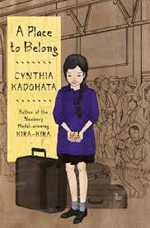 Twelve-year-old Hanako and her brother, born in the United States, and their parents, also U.S. citizens, are transported to Japan in 1946 when they are freed from the American internment camps where they had been incarcerated for five years. Along with other Japanese immigrants, her father had renounced his citizenship because, as Hanako’s mother explains to her, when the U.S. government came to him in the camp “he wasn’t sure he was safe in America.” As the family lives with her grandparents, tenant farmers, in a village not far from the remains of Hiroshima, and adapts to local customs, eking out a life in post-war Japan, Hanako realizes she has no home in her native country and is a stranger to life in Japan. Back matter includes an Afterword that provides historical context and further information about the citizenship of deported Japanese after World War II.
Twelve-year-old Hanako and her brother, born in the United States, and their parents, also U.S. citizens, are transported to Japan in 1946 when they are freed from the American internment camps where they had been incarcerated for five years. Along with other Japanese immigrants, her father had renounced his citizenship because, as Hanako’s mother explains to her, when the U.S. government came to him in the camp “he wasn’t sure he was safe in America.” As the family lives with her grandparents, tenant farmers, in a village not far from the remains of Hiroshima, and adapts to local customs, eking out a life in post-war Japan, Hanako realizes she has no home in her native country and is a stranger to life in Japan. Back matter includes an Afterword that provides historical context and further information about the citizenship of deported Japanese after World War II.
—SW
Ages 15+
Inventing Victoria. Tonya Bolden. 2019. Bloomsbury.
 A young black woman in 1880s Savannah, Georgia, Essie feels trapped between the life she has and the life she wants. She gets a chance to change her life when Ma Clara, a housekeeper for her mother and solace for her, advocates for her going to school. Ostracized and teased at school she leaves, still hungry for learning. Essie becomes housekeeper at Miss Abby’s boarding house, where she meets Dorcas Vachon, a wealthy, black socialite from Baltimore, Maryland, who offers her a new life but, as Victoria Vashon, she must break all ties with her past. Victoria harbors the secret of her origins and when she falls in love must decide whether to divulge the truth of her past. With its twists and revelations, the novel illustrates the power of patience, persistence, and the strength that comes from these qualities. Back matter includes an author’s note with information separating historical fact from conjecture and notes on research sources.
A young black woman in 1880s Savannah, Georgia, Essie feels trapped between the life she has and the life she wants. She gets a chance to change her life when Ma Clara, a housekeeper for her mother and solace for her, advocates for her going to school. Ostracized and teased at school she leaves, still hungry for learning. Essie becomes housekeeper at Miss Abby’s boarding house, where she meets Dorcas Vachon, a wealthy, black socialite from Baltimore, Maryland, who offers her a new life but, as Victoria Vashon, she must break all ties with her past. Victoria harbors the secret of her origins and when she falls in love must decide whether to divulge the truth of her past. With its twists and revelations, the novel illustrates the power of patience, persistence, and the strength that comes from these qualities. Back matter includes an author’s note with information separating historical fact from conjecture and notes on research sources.
—SW
When the Ground Is Hard. Malla Nunn. 2019. Putnam/Penguin.
 Sixteen-year-old Adele looks forward to returning to Keziah Christian Academy, a boarding school in the British protectorate of Swaziland, after a winter break with her mother and mixed-race brother, but finds she is no longer one of the top girls, rich and pretty students whose parents pay full fees, just as her white “sometimes father,” who lives in Johannesburg with his other family, does. Adele is assigned a small room with Lottie Diamond, a poor Swazi girl, who is tormented by the clique. Their lives are complicated as they try to find mentally challenged Darnell, who goes missing, the top girls accuse Lottie and Adele of a theft, a raging brush fire threatens the school buildings, and a poor, white landowner threatens people who approach his land. Through Lottie, Adele discovers new ways of being as she learns about her past and her culture. Readers learn about class and racial discrimination in Swaziland in the 1960s in this engrossing coming-of-age story.
Sixteen-year-old Adele looks forward to returning to Keziah Christian Academy, a boarding school in the British protectorate of Swaziland, after a winter break with her mother and mixed-race brother, but finds she is no longer one of the top girls, rich and pretty students whose parents pay full fees, just as her white “sometimes father,” who lives in Johannesburg with his other family, does. Adele is assigned a small room with Lottie Diamond, a poor Swazi girl, who is tormented by the clique. Their lives are complicated as they try to find mentally challenged Darnell, who goes missing, the top girls accuse Lottie and Adele of a theft, a raging brush fire threatens the school buildings, and a poor, white landowner threatens people who approach his land. Through Lottie, Adele discovers new ways of being as she learns about her past and her culture. Readers learn about class and racial discrimination in Swaziland in the 1960s in this engrossing coming-of-age story.
—SW
Sandip LeeAnne Wilson is a professor in the School of Education and the English Department of Husson University, Bangor, Maine, and is serving on the Children’s Literature and Reading SIG’s Notable Books for a Global Society Committee. Carolyn Angus is former director of the George G. Stone Center for Children's Books, Claremont Graduate University, in Claremont, California.
These reviews are submitted by members of the International Literacy Association's Children's Literature and Reading Special Interest Group (CL/R SIG) and are published weekly on Literacy Daily.